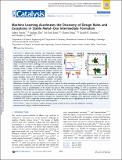| dc.contributor.author | Nandy, Aditya | |
| dc.contributor.author | Zhu, Jiazhou | |
| dc.contributor.author | Janet, Jon Paul | |
| dc.contributor.author | Duan, Chenru | |
| dc.contributor.author | Getman, Rachel B. | |
| dc.contributor.author | Kulik, Heather Janine | |
| dc.date.accessioned | 2019-09-23T18:30:58Z | |
| dc.date.available | 2019-09-23T18:30:58Z | |
| dc.date.issued | 2019-07 | |
| dc.date.submitted | 2019-06 | |
| dc.identifier.issn | 2155-5435 | |
| dc.identifier.issn | 2155-5435 | |
| dc.identifier.uri | https://hdl.handle.net/1721.1/122278 | |
| dc.description.abstract | Metal-oxo moieties are important catalytic intermediates in the selective partial oxidation of hydrocarbons and in water splitting. Stable metal-oxo species have reactive properties that vary depending on the spin state of the metal, complicating the development of structure-property relationships. To overcome these challenges, we train machine-learning (ML) models capable of predicting metal-oxo formation energies across a range of first-row metals, oxidation states, and spin states. Using connectivity-only features tailored for inorganic chemistry as inputs to kernel ridge regression or artificial neural network (ANN) ML models, we achieve good mean absolute errors (4-5 kcal/mol) on set-aside test data across a range of ligand orientations. Analysis of feature importance for oxo formation energy prediction reveals the dominance of nonlocal, electronic ligand properties in contrast to other transition metal complex properties (e.g., spin-state or ionization potential). We enumerate the theoretical catalyst space with an ANN, revealing expected trends in oxo formation energetics, such as destabilization of the metal-oxo species with increasing d-filling, as well as exceptions, such as weak correlations with indicators of oxidative stability of the metal in the resting state or unexpected spin-state dependence in reactivity. We carry out uncertainty-aware evolutionary optimization using the ANN to explore a > 37 000 candidate catalyst space. New metal and oxidation state combinations are uncovered and validated with density functional theory (DFT), including counterintuitive oxo formation energies for oxidatively stable complexes. This approach doubles the density of confirmed DFT leads in originally sparsely populated regions of property space, highlighting the potential of ML-model-driven discovery to uncover catalyst design rules and exceptions. Keywords: metal-oxo species; machine learning; density functional theory; spin-state-dependent reactivity; transition metal catalysis | en_US |
| dc.language.iso | en | |
| dc.publisher | American Chemical Society (ACS) | en_US |
| dc.relation.isversionof | http://dx.doi.org/10.1021/acscatal.9b02165 | en_US |
| dc.rights | Creative Commons Attribution-NonCommercial-NoDerivs License | en_US |
| dc.rights.uri | http://creativecommons.org/licenses/by-nc-nd/4.0/ | en_US |
| dc.source | ACS | en_US |
| dc.title | Machine Learning Accelerates the Discovery of Design Rules and Exceptions in Stable Metal–Oxo Intermediate Formation | en_US |
| dc.type | Article | en_US |
| dc.identifier.citation | Nandy, Aditya et al. "Machine Learning Accelerates the Discovery of Design Rules and Exceptions in Stable Metal–Oxo Intermediate Formation." ACS Catalysis 9, 9 (July 2019): 8243-8255 © 2019 American Chemical Society | en_US |
| dc.contributor.department | Massachusetts Institute of Technology. Department of Chemistry | en_US |
| dc.contributor.department | Massachusetts Institute of Technology. Department of Chemical Engineering | en_US |
| dc.relation.journal | ACS Catalysis | en_US |
| dc.eprint.version | Final published version | en_US |
| dc.type.uri | http://purl.org/eprint/type/JournalArticle | en_US |
| eprint.status | http://purl.org/eprint/status/PeerReviewed | en_US |
| dc.date.updated | 2019-09-20T13:55:21Z | |
| dspace.date.submission | 2019-09-20T13:55:24Z | |
| mit.journal.volume | 9 | en_US |
| mit.journal.issue | 9 | en_US |
